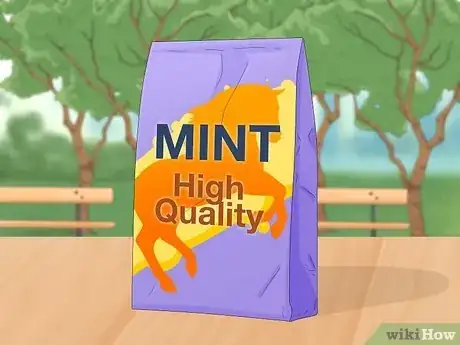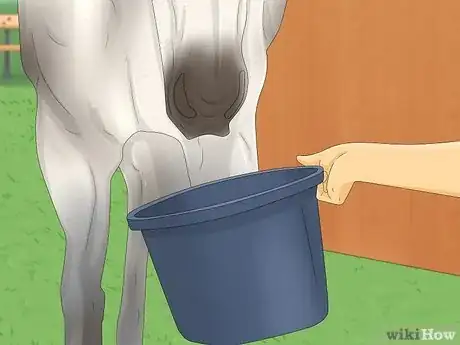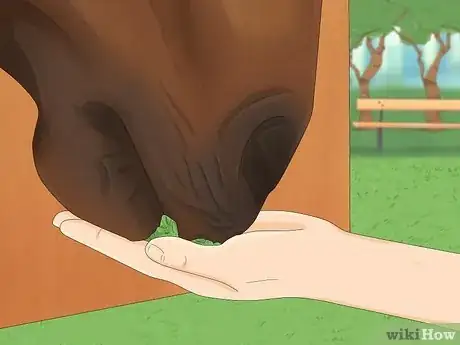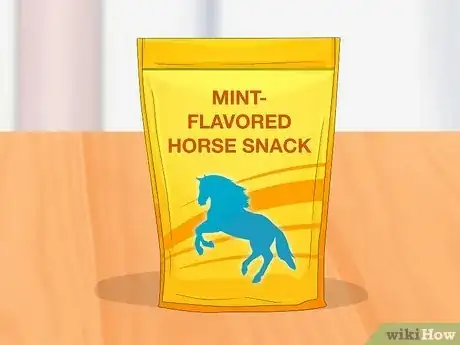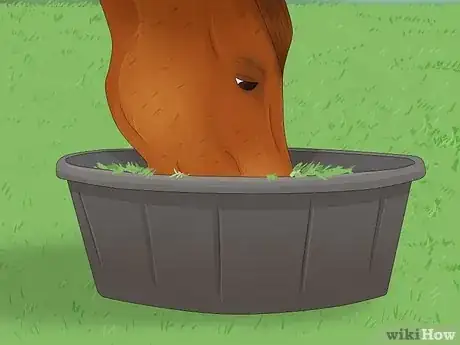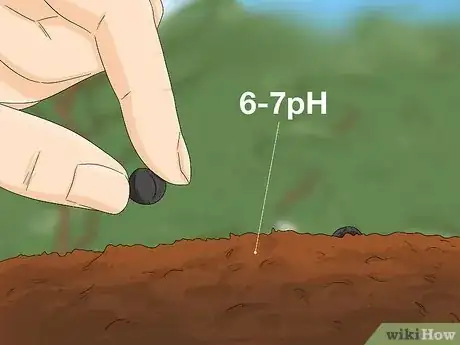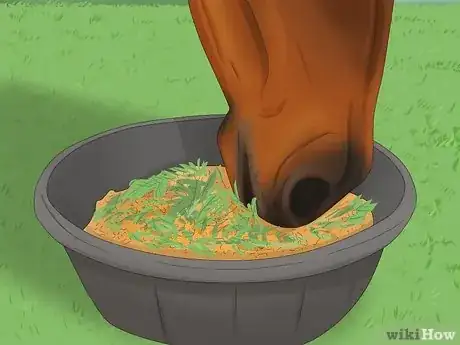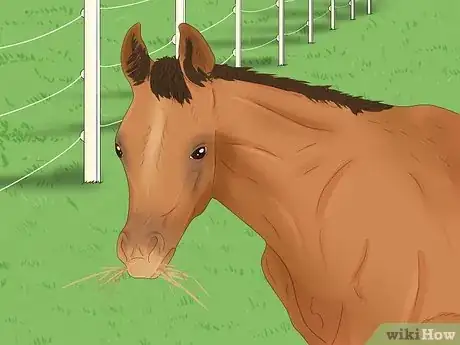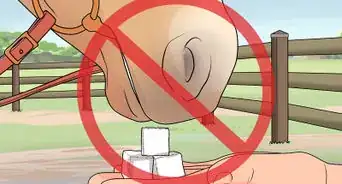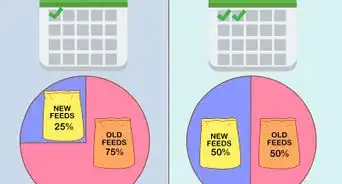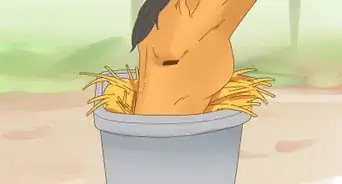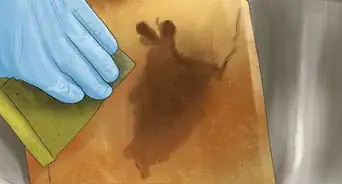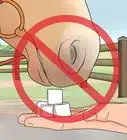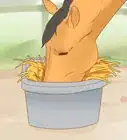This article was co-authored by Ryan Corrigan, LVT, VTS-EVN. Ryan Corrigan is a Licensed Veterinary Technician in California. She received her Bachelor of Science in Veterinary Technology from Purdue University in 2010. She is also a Member of the Academy of Equine Veterinary Nursing Technicians since 2011.
There are 9 references cited in this article, which can be found at the bottom of the page.
This article has been viewed 42,465 times.
Horses love mints. And why shouldn’t they? Not only are mints delicious, but they also contain astringents (compounds that heal skin) and help heal the digestive tract and lungs. They will also give your horse minty-fresh breath! Get a mint (preferably a sugar-free mint) and feed it to your horse by hand or in a pan. If feeding by hand, watch for signs of anxiety or discomfort in the horse and remove yourself to a safe distance if the horse seems uncomfortable around you.
Steps
Taking Care of the Necessities to Feed a Horse a Mint
-
1Obtain a mint. Both wrapped and unwrapped mints are available at most grocery stores. Horses enjoy both types, and will not mind either. Try to get a mint that is sugar-free. If you cannot find a sugar-free mint, it’s probably okay. However, horses with equine metabolic syndrome, Polysaccharide Storage Myopathy, or Cushing’s Disease cannot eat sugary mints.[1]
- If your mints are wrapped, be sure to remove the wrapper before feeding them to a horse. Over time, your horse will learn to recognize the sound of the wrapper and will get excited about its treat.
-
2Select a horse. Feed mints to gentle horses. A horse that tends to be calm and gentle is much easier to feed by hand than a high-strung horse that tends to bite or that may be pushy to try to get the mint. Larger horses might be more intimidating for you at first, so you might also want to start out by feeding a smaller horse.
- To get a feel for which horse is most relaxed, pet it gently on the forehead or nose when it is in its stall. If it doesn’t shy away, it is an especially docile horse and would be a good candidate to receive a mint.
- Some breeds are naturally calmer than others. Clydesdales, for instance, are known for their gentle demeanor. American Quarter Horses are also typically quite calm.
- Horses with a habit of chewing on human clothing or grooming brushes, or horses with a history of biting, will probably not be gentle when being fed by hand.[2] Do not hand-feed a horse with these habits.
Advertisement -
3Get the horse’s attention. If the horse you intend to feed a mint to is in an open pasture, you'll need to get it to approach you. You could use a verbal signal like “Mint!” or you could just make clicking or kissing sounds to get the horse’s attention.[3] Do not bang pots and pans together or yell in an aggressive way at the horse to get its attention. This will only scare the horse and cause it stress.
- Most horses will come to you easily if you talk gently to them and make kissing noises.
Offering the Mint
-
1Place the mint in front of the horse. The best place to put the mint is on a flat surface like a table or the ledge of a stall door that the horse can easily access. You could also toss the mint toward the horse if it is in a clean pasture. Finally, you could place the mint in a feeding pan.[4] Offer the pan to the horse by either placing the pan on the ground to the side of the horse or by holding the pan’s handle and bringing the mint up to within about five inches of the horse’s nose.
- Since horses cannot see straight ahead, hold items that you want the horse to see off to one side of the horse's head or the other.
-
2Feed the horse by hand. If you want to have a more intimate mint-feeding experience with a horse, stand next to the horse’s shoulder and flatten your hand. Make sure all your fingers are touching each other and your thumb is against the side of your hand. Place the mint in the center of your palm. When the horse’s head is turned just slightly off-center toward the side opposite you, bring the hand holding the mint under the horse’s neck to the front of its nose. Keep your hand splayed and straight about five inches from the horse’s nose.
- You will feel the horse's soft, fuzzy lips lapping up the mint into its mouth.
- Don't panic when you feel the horse's mouth touch your hand. Be confident that the horse won't bite you. If you make a sudden movement, such as pulling away, you could spook the horse.
- Wait until the horse lifts its head from your hand before you pull your hand back.
- If your horse becomes pushy or anxious (starts to gallop, pace, whinny, or rear back on its hind legs) when you’re feeding it a mint, walk away and do not give it the mint.[5] Don't reward pushy or aggressive behavior with treats. Try to feed it a mint again later if the horse is calm.
- Make sure an experienced handler is either holding the horse with a lead rope when feeding by hand, or close by when you’re in the stall with the horse.
-
3Incorporate mints into other foods.[6] Sprinkling crushed mint on apple slices, for instance, will excite your horse’s taste buds. Dropping a handful of peppermints into a jug of water for eight to ten hours can give the water a tasty, refreshing flavor that your horse will love. This is an especially useful method if you have a horse that doesn’t drink as much as he or she should.
- Alternately, commercially available mint-flavored horse snacks provide you with the chance to give your horse a special treat.
-
4Be generous with your horse. Horses cannot easily overdose on mints, so don’t worry about giving them too many.[7] As long as you limit mints to once or twice each day, your horse will be fine.[8]
- Don’t let mints replace a meal. Horses need to be fed plenty of hay and graze in the pasture for a healthy diet.
Feeding Your Horse Mint Leaves
-
1Obtain fresh mint leaves. Mint has anti-inflammatory, and antibacterial properties that will keep your horse healthy. The best way you can provide a steady supply of mint for your horse is to grow your own small herb garden.[9] Plant mint seeds in a soil with pH of six or seven. Seeds should be placed 18 to 24 inches apart and planted in spring. Keep the soil moist and water as needed.
- If you grow mint in a small garden that your horse can access, you won’t even have to feed it to your horse, and it can eat as much as it wants.
-
2Feed mint to cover other flavors.[10] If your horse needs to take a bitter medicine, for instance, you could wrap the pills in mint leaves and feed them to your horse. You could also feed your horse mint along with another herb in order to make the other herb more palatable.
- For example, if your horse needs to eat milk thistle but does not like the taste, you could feed it five or six leaves of mint along with the milk thistle. The next day, feed four or five leaves of mint along with the milk thistle. Gradually reduce the amount of mint leaves you give the horse and it will then be able to eat the milk thistle without the added mint.
-
3Use mint to help wean young horses. If you want to wean a horse off of its mother’s milk, feed the mare mint for about week. This will end milk production and help the weaning process along.[11]
-
4Create a mint infusion.[12] Place five or six mint leaves in a spray bottle. Fill the bottle with water and let it sit overnight. Mint leaves have anti-itch and cooling properties. Spray the mint infusion on the horse’s legs, flank, and back to cool it down and keep bugs at bay during the hot summer months.
- You could use dried or fresh mint for this infusion.
Expert Q&A
-
QuestionCan you feed horses fresh mint?
 Ryan Corrigan, LVT, VTS-EVNRyan Corrigan is a Licensed Veterinary Technician in California. She received her Bachelor of Science in Veterinary Technology from Purdue University in 2010. She is also a Member of the Academy of Equine Veterinary Nursing Technicians since 2011.
Ryan Corrigan, LVT, VTS-EVNRyan Corrigan is a Licensed Veterinary Technician in California. She received her Bachelor of Science in Veterinary Technology from Purdue University in 2010. She is also a Member of the Academy of Equine Veterinary Nursing Technicians since 2011.
Licensed Veterinary Technician Yes, you can do this. Mint is a very popular treat for horses and many enjoy it.
Yes, you can do this. Mint is a very popular treat for horses and many enjoy it. -
QuestionCan you feed a horse too many carrots?
 Ryan Corrigan, LVT, VTS-EVNRyan Corrigan is a Licensed Veterinary Technician in California. She received her Bachelor of Science in Veterinary Technology from Purdue University in 2010. She is also a Member of the Academy of Equine Veterinary Nursing Technicians since 2011.
Ryan Corrigan, LVT, VTS-EVNRyan Corrigan is a Licensed Veterinary Technician in California. She received her Bachelor of Science in Veterinary Technology from Purdue University in 2010. She is also a Member of the Academy of Equine Veterinary Nursing Technicians since 2011.
Licensed Veterinary Technician Carrots do have sugar in them so, as with any treat, they should be given only occasionally. How many carrots is too many depends on your horse and their body mass and workload.
Carrots do have sugar in them so, as with any treat, they should be given only occasionally. How many carrots is too many depends on your horse and their body mass and workload. -
QuestionWhat can horses eat?
 Ryan Corrigan, LVT, VTS-EVNRyan Corrigan is a Licensed Veterinary Technician in California. She received her Bachelor of Science in Veterinary Technology from Purdue University in 2010. She is also a Member of the Academy of Equine Veterinary Nursing Technicians since 2011.
Ryan Corrigan, LVT, VTS-EVNRyan Corrigan is a Licensed Veterinary Technician in California. She received her Bachelor of Science in Veterinary Technology from Purdue University in 2010. She is also a Member of the Academy of Equine Veterinary Nursing Technicians since 2011.
Licensed Veterinary Technician Horses are herbivores - the best things for horses to eat are fresh grass, hay (oat, timothy, grass, alfalfa), fruits, and vegetables. Carrots, bananas, apples, lettuce, watermelon are just a few things you can feed your horse. If you have any questions about whether a food item is safe for your horse, check with your veterinarian.
Horses are herbivores - the best things for horses to eat are fresh grass, hay (oat, timothy, grass, alfalfa), fruits, and vegetables. Carrots, bananas, apples, lettuce, watermelon are just a few things you can feed your horse. If you have any questions about whether a food item is safe for your horse, check with your veterinarian.
Warnings
- Do not feed your horse too many mints because it will make them obsess over the treats. They will constantly be in your personal space trying to find mints in your pockets.⧼thumbs_response⧽
- Check with the horse’s owner/supervisor to be sure that the horse is allowed to eat mints.⧼thumbs_response⧽
- Have an experienced horse expert to supervise you if you are a child.⧼thumbs_response⧽
- Be careful when feeding mints to racehorses. The volatile oils in mints could result in positive drug tests.⧼thumbs_response⧽
- Never feed mints to a horse you don't know or a horse whose owner you don't know.⧼thumbs_response⧽
References
- ↑ http://www.horsechannel.com/horse-news/2013/10/24-is-halloween-candy-safe-for-horses.aspx
- ↑ https://pethelpful.com/farm-pets/howtokeepahorsefrombiting
- ↑ http://www.thehorse.com/articles/28641/hand-feeding-treats
- ↑ http://www.thehorse.com/articles/28641/hand-feeding-treats
- ↑ http://www.thehorse.com/articles/28641/hand-feeding-treats
- ↑ http://www.equinews.com/article/everywhere-mint-peppermint-horses
- ↑ http://www.equinews.com/article/everywhere-mint-peppermint-horses
- ↑ http://www.horsechannel.com/horse-news/2013/10/24-is-halloween-candy-safe-for-horses.aspx
- ↑ http://holistichorse.com/health-care/plant-a-medicinal-herb-garden-for-your-horse/
About This Article
If you want to give your horse a minty treat, stand next to its shoulder, flatten your hand so all of your fingers touch each other, and place the mint in the center of your palm. When your horse’s head is turned slightly away from you, bring your hand about 5 inches away from its nose. You’ll feel your horse’s soft, fuzzy lips lapping the mint into its mouth, but don’t panic! Be confident that it won’t bite you and don’t make any sudden moves, like pulling away, or you could spook it. Wait until your horse lifts its head from your hand before you pull away. If your horse gets pushy or anxious, walk away and don’t give it the mint, as that will only reinforce the aggressive behavior with a treat. For more tips from our Veterinary co-author, like how to use mint to wean a young horse off its mother’s milk, scroll down!
